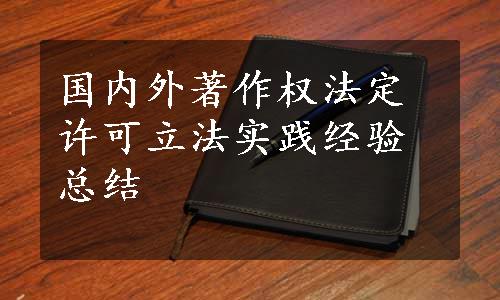
通过前文对著作权法定许可所涉及的国际公约考察,以及对两大法系典型国家及我国的相关立法概况的简单梳理,经归纳总结不难得出以下结论:
首先,著作权法定许可制度并非是自始就有的。它的产生与发展,乃是传播技术推动下对作品利用方式控制权斗争的结果。使用者凭借技术便利意图自由接触和利用作品与著作权人竭力掌控其作品发表后的使用许可权之间存在不可调和的矛盾。不难发现,不同法系的不同国家在适用法定许可缓解著作权人私人利益与社会公益之间的紧张关系时,共同的动因都出自于传播技术的挑战。由于两大法律体系历来在传统上存在较大的差异,加之世界各国在政治制度、经济发展、科技水平、文化观念等诸多层面也不尽相同,各国普遍倾向于立足国情而努力使著作权法定许可制度呈现出极具本土化的面貌。
其次,从《伯尔尼公约》到WPPT,国际著作权法中法定许可之演变显示出知识产权国际组织力图协调各国不同利益的呼声,为著作权法定许可立法明确相应的指导原则和基本方向。在经济全球化的大背景下,知识产权国际保护的一体化程度不断深化,各国以更加积极的姿态参与到知识产权国际条约的谈判中,更加注重不同国家与地区之间的知识产权保护政策协调性。
再次,虽然世界各国对著作权法定许可的具体规定存在千差万别的不同,但不可否认在具体制定过程中所考量的因素大体是相同的。既包含基于公共利益的需要的考量,又兼顾保障市场公平、防止市场垄断的担忧。
最后,历史事实已多次向人们证明,伴随传播技术的每一轮变革,原先处于平衡状态下的利益分配格局终将被打破。为了重构著作权法下各方利益再平衡,就有必要对著作权法在国际与国内两个层面中进行修正。但是,传播技术推动下著作权人权利扩张与权利限制总是处于短暂的平衡状态中,既有的法律秩序被不断打破,著作权法定许可的适用范围不可避免地受到冲击。基于此,有必要重申用“三步检验法”[32]原则对著作权限制制度(包括法定许可制度)进行严格约束和苛刻检验。简而言之,任凭传播技术的发展如何之迅速,外部环境的变化如何之激烈,我们在衡量一国著作权限制制度(包括法定许可制度)之时,必须严格按照“三步检验法”的要求对其适用顺序考量,且应当三个条件要同时满足。
【注释】
[1]在以国际角度审查著作权例外与限制制度时,必须要提到Sam Ricketson教授于2003年向WIPO版权与邻接权常务理事会提交的一份报告。该报告认为,无论是国际还是国家层面上,著作权限制与例外可为成三大类:第一,明确将某些特殊作品或事物从著作权保护领域予以排除;第二,著作权保护例外,如允许事关受保护作品的某些特别行为的发生,以及免除由此行为而导致的著作权侵权行为;第三,法定许可机制,确保一项原本需要严格限制的行为得到许可,只要就该使用行为提供某种形式的费用给权利人即可。See Sam Rickerson,WIPO Study on Limitations and Exceptions of Copyright and Related Rights in the Digital Environment,WIPO Document SCCR,2003(9):7~39.
[2]英文全称为:Berne Convention for the protection of Literary and Artistic Works.
[3]英文全称为:The Agreement on Trade-Related Aspects of Intellectual Property Rights.
[4]英文全称为:The WIPO performances and Phonograms Treaty.
[5]截至2012年3月14日,缔结方总数为165个国家,1992年10月15日我国成为该公约成员国。信息来源:http://baike.baidu.com/view/286638.htm?fromId=94276.
[6]罗向京:《著作权集体管理组织的发展与变异》,知识产权出版社,2011年,第114页。
[7]原文为:“It is understood that the manufacture and sale of instruments for the mechanical reproduction of musical airs in which copyright subsists shall not be considered as constituting an infringement of musical copyright.”
[8]See GUIDE to the BERNE CONVENTION for the Protection of Literary and Artistic Works(Paris Act.1971)Article 13,paragraph(1)Compulsory Licenses(1).
[9]See Michael Knes,Brene Convention.http://www.referenceforbusiness.com/encyclopedia/Assem-Braz/Berne-Convention,html.
[10]See Article 11bis(2)of Berne Convention(Brussels Revised):“It shall be a matter for legislation in the countries of the Union to determine the conditions under which the rights mentioned in the preceding paragraph may be exercised,but these conditions shall apply only in the countries where they have been prescribed.They shall not in any circumstances be prejudicial to the moral right of the author,nor to his right to obtain just remuneration which,in the absence of agreement,shall be fixed by competent authority.”
[11]英文全称为:The International Convention for the Protection of Performers,Producers of Phonograms and Broadcasting Organizations。
[12]See GUIDE to the ROME CONVENTION for the Protection of Performers,Producers of Phonograms and Broadcasting Organization(1961)Article 12[Secondary Uses of Phonograms].
[13]英文全称为:The Agreement on Trade-Related Aspects of Intellectual Property Rights。
[14]See Article 13 of TRIPS:“Members shall confine limitations and exceptions to exclusive rights to certain special cases which do not conflict with a normal exploitation of the work and do not unreasonably prejudice the legitimate interests of the right-holder.”(www.xing528.com)
[15]英文全称为:WIPO Copyright Treaty。
[16]See Article 1(4)of WIPO Copyright Treaty:“This provision requires Contracting Parties to comply with Article 1-21 and the Appendix of the Berne Convention….”
[17]An Agreed statement relative to WCT that was adopted by the 1996 Diplomatic Conference provides:“It is understood that the provisions of WCT permit Contracting parties to carry forward and appropriately extend into the digital environment limitations and exceptions in their national laws which have been considered acceptable under the Berne Convention.Similarly,these provisions should be understood to permit Contracting Parties to devise new exceptions and limitations that are appropriate in the digital network environment.”
[18]英文全称为The WIPO performances and Phonograms Treaty。
[19]冯晓青:《知识产权法利益平衡理论》,中国政法大学出版社,2006年,第249页。
[20]曹胜亮、段葳:《著作权限制制度比较研究》,载《西南民族大学学报》(人文社会科学版),2004年第7期。
[21]信息来源参见:http://baike.baidu.com/view/286638.htm?fromId=94276访问日期:2016年3月29日。
[22]陈建玲:《美国知识产权法》,对外经济贸易大学出版社,2007年,第24~30页。
[23]See,R.F.Whale,Copyright:Evolution,theory and practice,Rowman and littlefield,1972,p.162.
[24]Gillian Davies,Copyright and the public Interest,vol 14,1994,pp.27-28.
[25]吴汉东、胡开忠:《西方诸国著作权制度研究》,中国政法大学出版社,1998年,第310页。
[26]王清:《著作权限制制度比较研究》,人民出版社,2010年,第269页。
[27]同注释89。
[28]李扬:《日本知识产权法》,知识产权出版社,2011年,第89页。
[29]李扬:《日本知识产权法》,知识产权出版社,2011年,第25页。
[30][日]半田正夫、纹谷畅男编,魏启学译:《著作权法50讲》[M],北京:法律出版社,1990年版,第196-197页。
[31][日]田村善之著,周超、李雨峰、李希同译,张玉敏审校:《日本知识产权法(第4版)》[M],北京:知识产权出版社,2011年版,第463页。
[32]三步检验法(three-step test),根据1971年《伯尔尼公约》第9条第2款:在某种特殊的情况下(to be a certain case)不与作品的正常使用相冲突(not to conflict with the normal exploitation of the work),不致无故损害权利人的合法权益(not to unreasonably prejudice the legitimate interests of the right-holder)。《伯尔尼公约》要求成员国在其国内法中针对复制权设定例外时,必须要遵守三个必备条件。
免责声明:以上内容源自网络,版权归原作者所有,如有侵犯您的原创版权请告知,我们将尽快删除相关内容。




